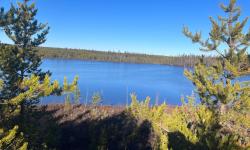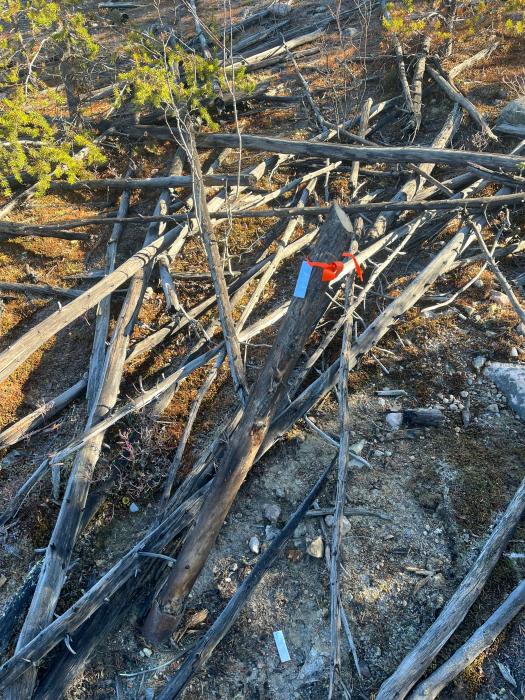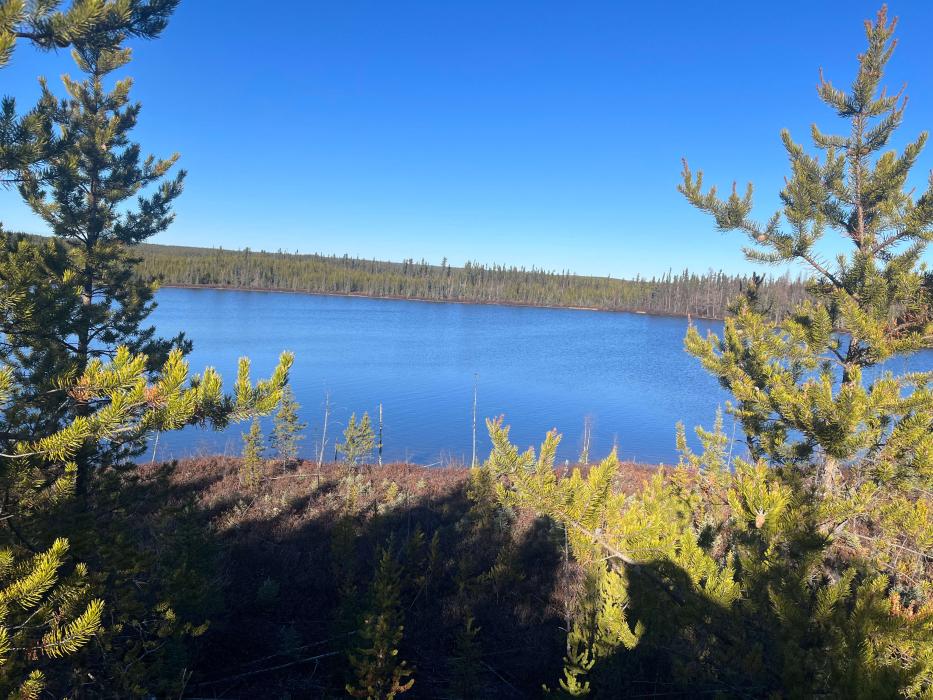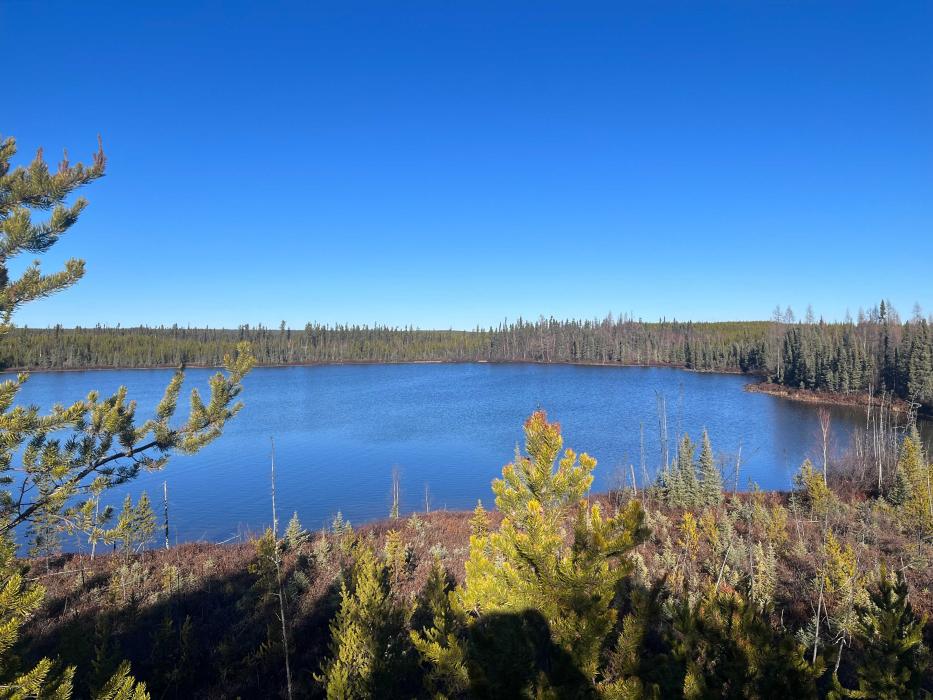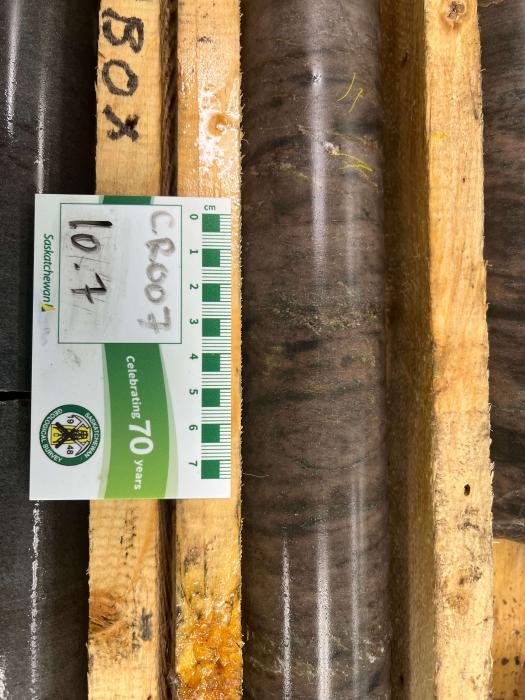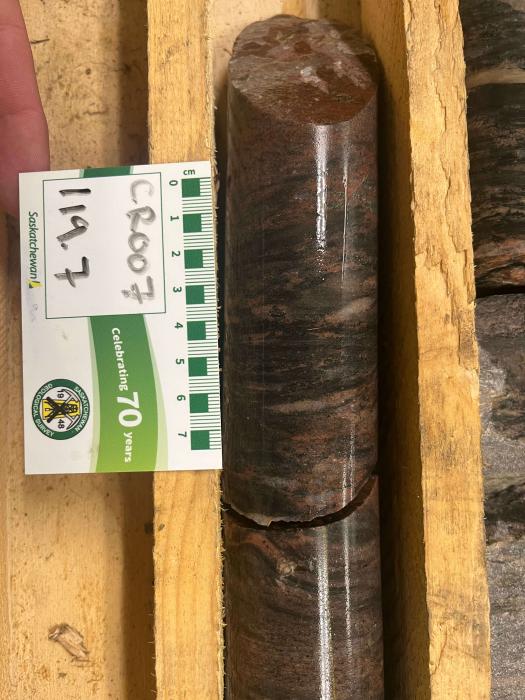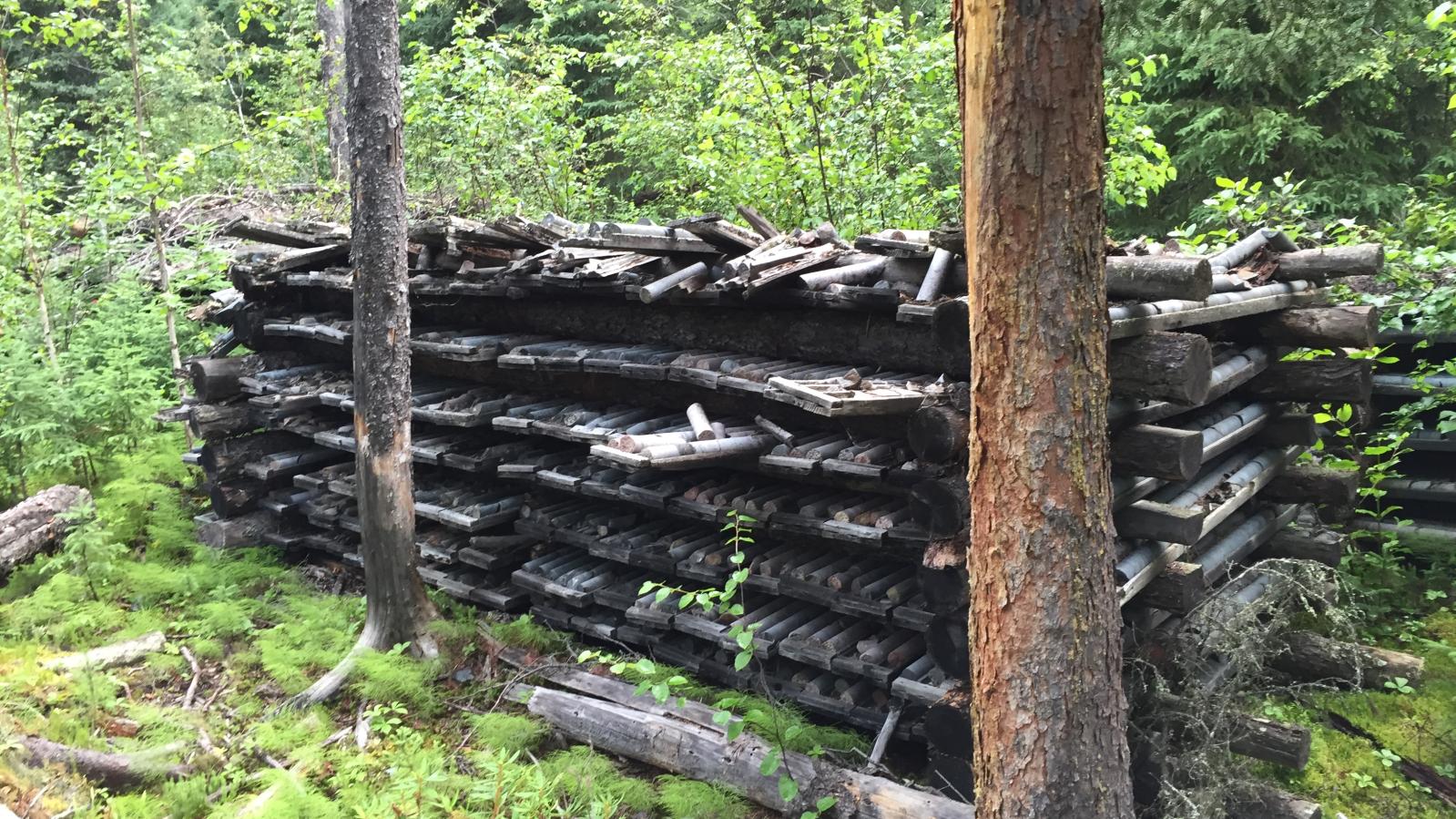
George Lake Project
The 6868 ha George Lake Property hosts the George Lake Zinc Deposit, a Sedimentary Exhalative (“SEDEX”) deposit with a historical resource (non-43-101 compliant) of approximately 5 million tonnes grading 3.5% Zn and 0.5% Pb.
The property is located 280 km northeast of La Ronge, Saskatchewan between Wollaston and Reindeer lakes. The property is road accessible via a spur road from hwy 905. This area qualifies for the mineral exploration incentive program.
-
- Saskatchewan
-
- Available for option: Yes
-
- Lead,
- Silver,
- Zinc
Project Highlights
- Host to the George Lake Zinc Deposit (SEDEX) containing a historical resource of 2.63 million tonnes grading 3.67% Zn and 0.53% Pb*
- Deposit mineralization is open along strike and to depth
- Excellent geology highly prospective for SEDEX and quartz vein mineralization
- Contains multiple untested coincident geophysical anomalies that are proven targets for stratabound sulfide mineralization
- Excellent Infrastructure - an all-season road spur from Hwy 905 bisects the property
*Eagle Plains’ management considers these estimates to be historical in nature and cautions that a Qualified Person has not done sufficient work to classify the historical estimates as current mineral resources or mineral reserves in accordance with National Instrument 43-101. These estimates do not comply with current definitions prescribed by National Instrument 43-101 or the Canadian Institute of Mining, and are disclosed only as indications of the presence of mineralization and are considered to be a guide for additional work. The historical models and data sets used to prepare these historical estimates are not available to Eagle Plains, nor are any more recent resource estimates or drill information on the property.
Summary
The 6868 ha George Lake Property hosts the George Lake Zinc Deposit, a Sedimentary Exhalative (“SEDEX”) deposit with a historical resource (non-43-101 compliant) of approximately 5 million tonnes grading 3.5% Zn and 0.5% Pb.
The property is located 280km northeast of La Ronge, Saskatchewan between Wollaston and Reindeer lakes. The property is road accessible via a spur road from hwy 905. The claims are 100% owned by Eagle Plains with a 2% NSR held by Eagle Royalties containing a 1% buy-back clause. This area qualifies for the mineral exploration incentive program.
Project Highlights
- Host to the George Lake Zinc Deposit (SEDEX) containing a historical resource of 2.63 million tonnes grading 3.67% Zn and 0.53% Pb*
- Deposit mineralization is open along strike and to depth
- Excellent geology highly prospective for SEDEX and quartz vein mineralization
- Contains multiple untested coincident geophysical anomalies that are proven targets for stratabound sulfide mineralization
- Excellent Infrastructure - an all-season road spur from Hwy 905 bisects the property
*Eagle Plains’ management considers these estimates to be historical in nature and cautions that a Qualified Person has not done sufficient work to classify the historical estimates as current mineral resources or mineral reserves in accordance with National Instrument 43-101. These estimates do not comply with current definitions prescribed by National Instrument 43-101 or the Canadian Institute of Mining, and are disclosed only as indications of the presence of mineralization and are considered to be a guide for additional work. The historical models and data sets used to prepare these historical estimates are not available to Eagle Plains, nor are any more recent resource estimates or drill information on the property.
Geology
The George Lake property is found in the Wollaston domain which is host to several significant base metal occurrences. In the George Lake area, SEDEX-type Pb-Zn-Ag mineralization is found in quartzite and meta-argillite of the Souter Lake group and Spence Lake formation, respectively. Mineralization in the Souter Lake group occurs as stratabound, disseminated sulfides comprising pyrite, pyrrhotite, sphalerite, and galena. Mineralization in the Spence Lake Formation occurs as stratiform disseminated pyrrhotite, pyrite, sphalerite, and galena, and as vein-hosted arsenopyrite, pyrite, pyrrhotite, and subordinate sphalerite and galena. Mineralization in both units is associated with syn-depositional faulting.
History
Exploration in the George Lake area was carried out by industry with multiple programs between 1965 and 2008. Geological mapping of the area was undertaken by the government in 1977.
Airborne geophysical surveying followed by mapping and prospecting led to the discovery of the 55km boulder train centrered roughly around George Lake. Further exploration programs to 1970 included mapping, ground geophysics, soil geochemistry and diamond drilling that resulted in the delineation of the George Lake deposit over a strike of 15km, averaging 45–60m deep and up to 150m. A historic (Non 43-101) resource was calculated to be 5MT @ 2.65% Zn and 0.38% Pb and including a high-grade zone of 2.9 MT @ 3.67% Zn and 0.53% Pb.
From the 1980’s to 2008, other companies conducted multiple exploration programs on the project area including lake sediment, soil, and glacial till geochemical surveys, geological mapping, and various types of geophysical surveys and diamond drilling noting the potential for base metal mineralization in the area.
George Lake Zones
George Lake is prospective for critical-metal mineralization in two zones. The George Lake Zone that contains a historic Zn/Pb resource which is open along strike and to depth and the Spence Lake Zone where surface sampling and drilling indicate the potential for both stratabound and vein-hosted mineralization
Eagle Plains Exploration
In 2023 Eagle Plains Resources compiled the available data for the George Lake area and identified the above mentioned zones as being prospective for significant critical-metal mineralization.
Future Work
Future exploration work should focus on SEDEX-type Pb-Zn-Ag mineralization in the sandstone-hosted Souter Lake and shale-hosted Spence Lake formations. The Souter Lake formation has proven to be more prospective than Spence Lake, however, mineralized quartz veins in the Spence Lake formation are of significant interest.
SEDEX exploration is to focus on coincident NE-SW trending EM and magnetic anomalies with the primary exploration targets being the along-strike continuation of Pb-Zn-Ag mineralization in the Souter Lake and Spence Lake formations.
Recommended exploration work for the George Lake Property includes compilation/modelling of the drill core and geochemical data to identify exploratory gaps and target areas for modern exploration techniques. Field work should include soil sampling, airborne and ground based time-domain EM & magnetic surveys, and diamond drilling.
Eagle Plains - A Project Generator
Eagle Plains Resources is a project generator with several mineral exploration properties of merit that meet qualifying transaction requirements. We facilitate the listing process for capital pool companies and initial public offerings while providing technical expertise for exploration programs. Companies interested in co-operatively exploring any of our projects please contact: Chuck Downie at ccd@eagleplains.com or Mike Labach at mgl@eagleplains.com or call 1 866 Hunt Ore (486 8673).
Details
The 6868 ha George Lake Property hosts the George Lake Zinc Deposit, a Sedimentary Exhalative (“SEDEX”) deposit with a historical resource (non-43-101 compliant) of approximately 5 million tonnes grading 3.5% Zn and 0.5% Pb.
The property lays 280km northeast of La Ronge, Saskatchewan between Wollaston and Reindeer lakes. The property is road accessible via a spur from hwy 905. The claims are 100% owned by Eagle Plains with a 2% NSR held by Eagle Royalties containing a 1% buy-back clause. This area qualifies for the mineral exploration incentive program.
Project Highlights
- Host to the George Lake Zinc Deposit (SEDEX) containing a historical resource of 2.63 million tonnes grading 3.67% Zn and 0.53% Pb*
- Deposit mineralization is open along strike and to depth
- Excellent geology highly prospective for SEDEX and quartz vein mineralization
- Contains multiple untested coincident geophysical anomalies that are proven targets for stratabound sulfide mineralization
- Excellent Infrastructure - an all-season road spur from Hwy 905 bisects the property
*Eagle Plains’ management considers these estimates to be historical in nature and cautions that a Qualified Person has not done sufficient work to classify the historical estimates as current mineral resources or mineral reserves in accordance with National Instrument 43-101. These estimates do not comply with current definitions prescribed by National Instrument 43-101 or the Canadian Institute of Mining, and are disclosed only as indications of the presence of mineralization and are considered to be a guide for additional work. The historical models and data sets used to prepare these historical estimates are not available to Eagle Plains, nor are any more recent resource estimates or drill information on the property.
Geology
The George Lake property is found in the Wollaston domain, and comprises greenschist-amphibolite facies metasedimentary and minor metavolcanic rocks of the middle Paleoproterozoic Wollaston Supergroup. The Wollaston domain is bounded to the southeast by late Archean gneisses of the Peter Lake domain, which are locally unconformably overlain by the Wollaston Supergroup. To the northwest, the Wollaston domain is transitional to the Mudjatik domain comprising Archean gneiss. Both the Wollaston and Mudjatik domains are unconformably overlain by the Athabasca basin, a late Paleoproterozoic clastic sedimentary basin.
Metasedimentary rocks in the southeast Wollaston domain host several significant base metal occurrences. In the George Lake area, SEDEX-type Pb-Zn-Ag mineralization is found in quartzite and meta-argillite of the Souter Lake group and Spence Lake formation, respectively. Mineralization in the Souter Lake group occurs as stratabound, disseminated sulfides comprising pyrite, pyrrhotite, sphalerite, and galena in a white and grey quartzite. Mineralization in the Spence Lake formation occurs as stratiform disseminated pyrrhotite, pyrite, sphalerite, and galena, and as vein-hosted arsenopyrite, pyrite, pyrrhotite, and subordinate sphalerite and galena.
The George Lake property is on the southeastern edge of the Wollaston domain in the Compulsion River fold belt. Rocks underlying the George Lake property comprise greenschist to amphibolite metasedimentary sequences of Wollaston Supergroup. Metamorphic grade generally increases to the northwest, where rocks of the Marginal Pelite unit are amphibolite facies and primary fabrics are obscured. Primary structures are preserved in the lower grade rocks occupying most of the property area. Bedding is very steeply dipping to vertical and locally overturned on the northwest limb of the Spence Lake Synform. Rapid thickening and facies changes in sedimentary units suggests syndepositional faulting on north-south trending faults.
The dominant structural grain of the property is a steeply northwest dipping foliation, axial planar to the Spence Lake Synform. This fabric has been weakly overprinted by conjugate northeast and southwest plunging folds. A late north-south trending sinistral fault zone cuts all units and displaces lithologic contacts in the southwestern portion of the property area.
Mineral occurrences on the George Lake Property include stratabound, disseminated sphalerite and galena, and vein-hosted arsenopyrite, sphalerite, and galena, interpreted as SEDEX-type mineralization. Stratabound Pb-Zn-Ag-mineralization is predominantly found disseminated in quartzite of the upper Souter Lake group near the contact with the overlying meta-argillite. The Spence Lake Formation also hosts stratabound Pb-Zn-Ag mineralization, but at lower grades. Vein-hosted arsenopyrite, galena, and sphalerite are predominantly found as blebs in quartz-veins hosted in meta-argillite of the Spence Lake formation, as well as disseminated grains in the host rock. Non-visible silver is associated with both mineralization styles in the George Lake property.
History
Reconnaissance exploration in the George Lake area began in 1965 with a geophysical aeromagnetic survey followed up with mapping and prospecting. Sphalerite- and galena-bearing quartzite boulder trains were discovered at the southwest end of George Lake extending 15 km southwest and 40 km northeast of George Lake. Two sphalerite bearing outcrops were discovered at the south end of George Lake and 18 trenches excavated but thick overburden prevented significant exposure of bedrock. 2 diamond drill holes (112m) did not intersect any mineralization.
In the summer of 1965 Falconbridge Nickel Mines Ltd. staked George Lake and surrounding area and in 1966 completed mapping, ground geophysics, soil geochemistry. Four diamond drill holes (894m) were completed to test magnetic geophysical anomalies and interpreted the source to be minor pyrrhotite- and pyrite-bearing meta-argillite and quartzite and garnet biotite schist. Mineralization was discovered in the fall of 1966. In 1967, further geologic mapping, soil surveys, and ground magnetic surveys completed coverage of the area and helped trace stratigraphic contacts covered by overburden.
From 1969-1970, Compulsion River Mines Ltd. drilled 34 holes (5127m) to delineate the George Lake deposit over a strike length of approximately 15 km. Most drill holes intersected mineralization at 45–60m vertical depth, while 3 deeper holes extended mineralization to below 150m. A resource was approximated to be 5 million tonnes grading 2.65% Zn and 0.38% Pb (1% Zn cutoff), including a high-grade zone containing 2.9 million tonnes grading 3.67% Zn and 0.53% Pb (2% Zn cutoff).
In 1977 the government of Saskatchewan produced a geologic map of the area.
In 1980 and 1981, Pressuag Canada and Saskatchewan Mining and Development Corporation (SMDC) explored the George Lake area for stratabound base-metal mineralization. Work included lake sediment, soil, and glacial till geochemical surveys, geological mapping, and magnetic/EM geophysical surveys. In 1983/4 the SMDC conducted geologic mapping, soil geochemical surveys, and magnetic/VLF-EM geophysical surveys noting the potential for base metal mineralization in the area.
In 1986, Esso Minerals Canada conducted preliminary lithogeochemical sampling, airborne magnetic and EM geophysical surveys in the George Lake area. Ground geochemical and geophysics surveys were conducted over target areas in 1987 and 1988 followed by 5 diamond drill holes (527m) which intersected iron formation and Zn-enriched strata. Later that year an Esso/Bow Valley Industries JV conducted soil geochemical surveys and reinterpreted the airborne geophysics. 12 diamond drill holes (1471m) were completed intersecting subeconomic base-metal mineralization at several targets.
In 1990, Falconbridge flew EM, VLF-EM, and magnetic geophysical surveys that covered the George Lake deposit. Drill core from 1965-1970 was also relogged and resampled for multielement geochemical analysis.
In 1992, Noranda Exploration and Mining Company conducted a genie-EM geophysical survey along a slate horizon which traced a stratigraphic boundary beneath thick overburden. Two diamond drill holes (301m) tested the lower stratigraphy of the Souter Lake formation and did not intersect any significant mineralization.
From 1995-1998, Far West Mining completed bulk till and soil geochemical sampling across a very large area including the George Lake property. A Zn-anomaly was identified on the north shore of George Lake.
In 2002, Odaat identified a zone of elevated magnetics over the deposit location. Southwestward shifts in the magnetic anomalies were interpreted as potential faults and additional magnetic geophysical surveys were recommended.
In 2008, Golden Arch Resources drilled 6 holes (1706m) along the main George Lake deposit showing. Drill core data correlated very well with previous drill results and identified a notable Ag-resource that was previously undescribed.
George Lake Zones
George Lake Zone
The most prospective area of the property is the George Lake Zn Zone, an 8 km long trend of sandstone-hosted Zn-Pb-Ag mineralization located at the top of the Souter Lake Formation quartzite. Drilling indicates the top of mineralization occurs within 5–25m of the contact with the overlying George Lake Formation meta-argillite and is concentrated within the upper 60m of the Souter Lake formation. The George Lake Zn Deposit, situated in the core of the property, is hosted in this Zone with a historic resource 2.63MT grading 3.67% Zn and 0.53% Pb. Within this resource a zone of higher-grade Zn-mineralization in excess of 5% plunges shallowly to the east. Diamond drilling indicates the deposit is lensoid in shape, 800m long, ~35m thick, and extends at least 150m in depth.
Spence Lake Zone
Spence Lake Zone is prospective and underexplored. Pb-Zn-Ag assays of surface samples and drill core indicate the potential for both stratabound and vein hosted mineralization. Vein assays yield the highest concentrations of metal, particularly silver, and stockwork structures may host high-grade mineralization.
Coincident magnetic and EM anomalies typically outline stratabound pyrite and pyrrhotite mineralization which may or may not contain base-metal mineralization. Geophysical anomalies may therefore represent lithogeochemical haloes locally associated with Pb-Zn-Ag mineralization.
Eagle Plains Exploration
In 2023 Eagle Plains Resources compiled the available data for the George Lake area and found that mineralization on the property occurs as low grade (<5% Pb or Zn) stratabound disseminated pyrrhotite, pyrite, sphalerite, galena, arsenopyrite, and non-visible silver in quartzite, meta-argillite, and quartz vein hosts. Mineralization in both the Souter Lake and Spence Lake formations is genetically linked to deposition of iron formation in the upper Spence Lake Formation. Metalliferous fluids migrating along a syndepositional fault zone percolated out into the permeable Souter Lake quartzite and precipitated sphalerite, pyrrhotite, pyrite, and minor galena below an impermeable argillitic cap rock. Metalliferous fluids exhaled at the surface deposited Pb-Zn bearing iron formation and stratiform sphalerite and galena in the upper Spence Lake formation. Concordant quartz veins host higher concentrations of Pb-Zn-Ag, suggesting connections to hydrothermal feeder zones. Sphalerite- and galena-bearing mineralized hairline fractures indicate deformation and metamorphism occurred after deposition of the sulfides and also remobilized sulfides. There are two areas prospective for significant mineralization.
Future Work
Future exploration work should focus on SEDEX-type Pb-Zn-Ag mineralization in the sandstone-hosted Souter Lake and shale-hosted Spence Lake formations. Sandstone-hosted mineralization in the Souter Lake formation has proven to be more prospective than shale-hosted mineralization in the Spence Lake formation. However, mineralized quartz veins in the Spence Lake formation are of significant interest.
SEDEX exploration should focus on coincident NE-SW trending EM and magnetic anomalies. Sedimentary bedding is steeply dipping, trending NE-SW, therefore stratabound SEDEX mineralization will mirror this attitude.
Along-strike continuation of Pb-Zn-Ag mineralization in the Souter Lake and Spence Lake formations are the primary exploration targets. Mineralization in this formation has been shown to extend at least 8 km along strike with potential high-grade zones locally developed and spatially restricted. In the Spence Lake formation, concordant quartz veins yield the highest concentrations of Pb-Zn-Ag and may be connected to hydrothermal feeder zones. Syndepositional fault zones in the Souter Lake and Spence Lake formations likely operated as hydrothermal fluid conduits, forming feeder zones that could host high-grade Pb-Zn-Ag mineralization.
Magnetic highs and EM conductors northeast and southwest of the George Lake deposit are poorly explored. Their position immediately above the quartzite–meta-argilite mimics the geophysical anomaly of the George Lake deposit and warrant additional investigation.
In the far southwest of the property, a localized magnetic and EM anomaly overlying the Spence Lake formation is an attractive, undrilled target. This anomaly is located along-strike of proven mineralization and warrants investigation.
In the far northeast corner of the property, a magnetic and EM anomaly are associated with iron formation of the Spence Lake formation. Iron-exhalites may be genetically linked to SEDEX-type mineralization and are worth further investigation.
Recommended exploration work for the George Lake Property includes data compilation of diamond drill hole logs, drill core geochemistry, and soil/rock geochemistry. This will help to identify exploratory gaps and identify target areas that would benefit from modern exploration tequniques. Field work should include soil sampling, airborne and ground based time-domain EM & magnetic surveys, and diamond drilling.
Modelling of drill core data to constrain subsurface geology and mineralization attitudes including delineation of the George Lake deposit and identification of new targets.
Improve delineation of geochemical anomalies with modern analytical precision and targeted sampling. Soil sampling below the upper boundaries of the Souter Lake and Spence Lake formations to better resolve geochemical anomalies and indicate exploration targets when coincident with geophysical anomalies. Conduct soil sampling along-strike to the northeast of the George Lake deposit, a zone with relatively little historical exploration work.
Coincident EM conductors and magnetic highs are proven targets associated with stratabound sulfide mineralization in the George Lake area. EM and magnetic geophysical surveys to delineating the location and trend of sulfide-bearing layers along the upper boundary of the Souter Lake group and within the Spence Lake Formation which have been proven to host significant SEDEX-style Pb-Zn-Ag mineralization. Modern geophysics will better model and derive more detailed interpretations of anomalies.
The high-grade (>5% Zn) core of the George Lake deposit plunges shallowly to the east and should be further investigated with diamond drilling to determine its spatial relationship to the stratabound deposit.
Iron formation at the top of the Spence Lake formation in the northeast corner of the property is an unexplored area of the property. Ore genesis models of the George Lake deposit suggest deposition of the iron formation is genetically related to stratabound Pb-Zn-Ag mineralization, and therefore may be a base-metal host. Investigation of the iron formation may indicate the source of metalliferous fluids with the potential for high-grade mineralization.
Eagle Plains - A Project Generator
Eagle Plains Resources is a project generator with several mineral exploration properties of merit that meet qualifying transaction requirements. We facilitate the listing process for capital pool companies and initial public offerings while providing technical expertise for exploration programs. Companies interested in co-operatively exploring any of our projects please contact: Chuck Downie at ccd@eagleplains.com or Mike Labach at mgl@eagleplains.com or call 1 866 Hunt Ore (486 8673).
Updated October 29, 2024

